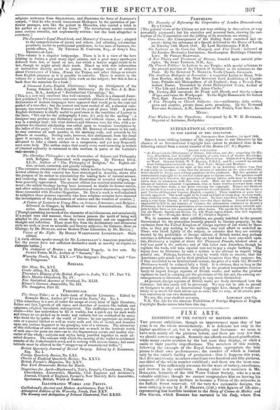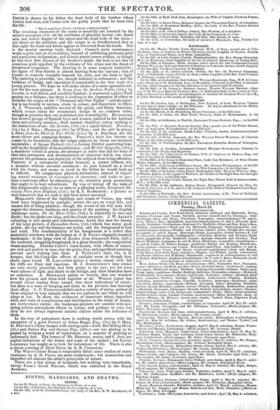FINE ARTS.
EXHIBITION OF THE SOCIETY OF BRITISH ARTISTS.
THE present exhibition, though an improvement upon that of last year, is on the whole unsatisfactory. It is deficient not only in the higher qualities of art, but in originality and freshness : we seem to have seen nearly all the pictures before, and there are very few that we should care to see again. Scarcely one affords unalloyed gratification, while many excite aversion by the bad taste they display, or elicit a smile at their puerile imperfections. The members of this society, following the example of the Royal Academy, appropriate the best places to their own performances ; the number of which is limited only by the artist's facility of production : thus it happens this year, that five-and-twenty members contribute two hundred and fifty pictures, one-third of the whole number exhibited ; and these are the most con- spicuous. This sufficiently accounts for the want of variety, excellence, and interest in the exhibition. Among other new members is Mr. HOLLAND, formerly of the Old Water Colour Society, who is a most valuable addition ; though we cannot congratulate him on leaving his compeers of the watery medium to become a Triton of the minnows in the Suffolk Street reservoir. Of the very few noticeable designs, the most striking is one 1)7 J. F. HEsPny, (149,) with figures of life-size ; representing that horrible incident in the Story of Cosmo de Medici and Don Garzia, which Roozas has narrated in his Italy, where Don
Garzia is shown by his father the dead body of his brother whom Garzia had slain, and Cosmo tells the guilty youth that he must take his life : "Blood must have blood-and from a father's hand."
The revolting character of the scene is assuredly not lessened by the artist's treatment of it : all the attributes of physical horror-the bared arm and naked dagger of the slayer and the dead body of the slain- are thrust on the attention, and the corpse is so foreshortened that at first sight the head and hands appear as if severed from the trunk. Nor is the mental emotion truly depicted : Cosmo's stern countenance wears a grim leer as of exultation, instead of exhibiting profound grief
and passionate indignation ; and Garzia stands terror- striken, as though he had then first known of his brother's death : his look is not that of conscious guilt appalled by the evidence of his crime and the dread of threatened vengeance. The drawing is in some respects admirable : the figure of Don Garzia is almost starting from the canvass ; that of Cosmo is scarcely traceable beneath his robe, and the head is rigid. The painting is powerful, too, though deficient in refinement ; and the boldness of design and execution is remarkable in the first work of a young painter. We hope he will make choice of a more agreeable sub- ject for his next picture. A Scene from the Arabian Nights, (164,) by Jecom, is weRdrawn and carefully finished : it represents a grave Turk razing on a Sultana ; but there is nothing in the expression of either to intimate the origin of the "Thousand and One Nights ": and the paint- ing is tea-boardy in texture, crude in colour, and discordant in effect. A. J. WooLsrEe exhibits several of his gaudy and flimsy fantasies ; which evince talent for ornamental design of no common order, though as pictures they are unfinished and unintelligible. HURLSTONE has several groups of Spanish boys and women, painted in his habitual dirty and slovenly manners; their natural character owing nothing to the attractions of art : his Armida, (106,) is a signal failure. Dorothea, (34,) by J. HILL ; Margaret, (86,) by O'NEIL ; and the girl in prison, a Scene from the Devil on Two Sticks, (2540 by A. SOLOMAN, are the most clever and engaging designs. PRENTIS'S style has become so coarse in its literalness, that the vulgar subjects he treats are rendered intolerable : A Sponge Defined, (10,) a Jeremy Diddler quartering him- self on the hospitality of an acquaintance ; and Morbid Sympathy, (265,) a murderer visited in prison, are attempts at satire that fail for want of that nice perception and discrimination of character which can alone prevent the grossness and depravity of the subjects from being offensive. PRENTIS is a caricaturist without humour, a censor without wit, a moralist without elevated sentiment : he puts himself on a level with his theme, and seems to revel in the follies he would hold up to ridicule. He exaggerates physical deformities, instead of depict- ing mental weakness or viciousness of character ; and seeks to pro- duce a ludicrous effect by obtruding on the attention petty accessories that ought to be kept subordinate. By way of taking off the taste of this disagreeable subject, let us turn to a pleasing scene, Emigrants Re- ceiving News from England, (150,) by R. J. HAMERTON ; a picture so well conceived that we wish it had been better executed.
HOLLAND'S views of the buildings and canals of Venice, gay with local hues brightened by sunlight, attract the eye on every side, and cannot fail of being admired ; though the lovers of art will note with regret the thinness, hardness, and opacity of the painting : his English landscape scene, On the River Coble, (523,) is admirable in tone and finish ; but the darks are inky, and the clouds are paint. J. W. ALLEN'S colouring is still spotty and inharmonious ; faults that mar the beauty of his large picture, A .Devonshire Scene, (I65,) which has many good points: the sky and the distance are aerial, and the foreground is rich and solid. The insubstantiality of his foregrounds is a defect that materially interferes with the beauty of J. B. FYNE'S elegantly-touched landscapes : in his large view of London from Greenwich Park, (227,) the scattered, straggling foreground, is a great blemish ; the composition wants massing. ALFRED CLINT'S coast-scenes, with effects of sunset, are rich and mellow in tone ; but the petite, liny, and superficial painting, prevent one's looking into them. J. TENNANT'S style, too, is so meagre, that his Cuyp-like effects of sunlight seem as though they shone upon board. H. LANCASTER paints a stormy sunset well, but his cliffs are filmy and vaporous. H. J. BODDINGTON'S lane scenes are very neatly pencilled, and look pretty to the eye ; yet his trees want masses of light and shade to the foliage, and their branches have no substance. A. MONTAGUE paints so loosely, that one wonders how his ground and trees hold together at all. WILSON junior has several clever studies from nature, that show indications of talent ; but there is a want of keeping and unity in his pictures that destroys their effect. C. F. TOMKINS exhibits such a variety of styles, neither of them original or very natural, that we are curious to see which he will adopt at last. In short, the evidences of immature talent, imperfect skill, and want of completeness and intelligence in the study of nature, are everywhere: visible : the landscape-painters are content with imi- tating certain atmospheric effects in colour, and perhaps in tone, but they do not always represent natural objects under the influence of them.
In the way of portraiture there is nothing worth notice, with the
exception of a good Portrait of Is/tam Boggs, Esq., (70,) by J. Hum. G. SrEvErts's China images with staring eyes-Little Red Riding Hood, (21,) and Italian Boy and Guinea Pigs, (493,)-are too glaring to be passed by without a word of reprobation on a manner of painting so ludicrously bad. The horses of Mr. HERRING senior, and C. Josr, are capital imitations of the forms and coats of the animal ; but EDWIN LANDSEER has taught us to look for indications of life. There is also a clever painting of Dead Game, by A. R. Coursouko.
The Water-Colour Room is respectably filled : some studies of rustic character, by A. D. FRIPP, are most conspicuous ; but mannerism and imperfect art obscure the artist's perception of nature. There are a few pieces of sculpture, but nothing very remarkable, except Psitx's Greek Warrior, which was exhibited at the Royal Academy.



























 Previous page
Previous page